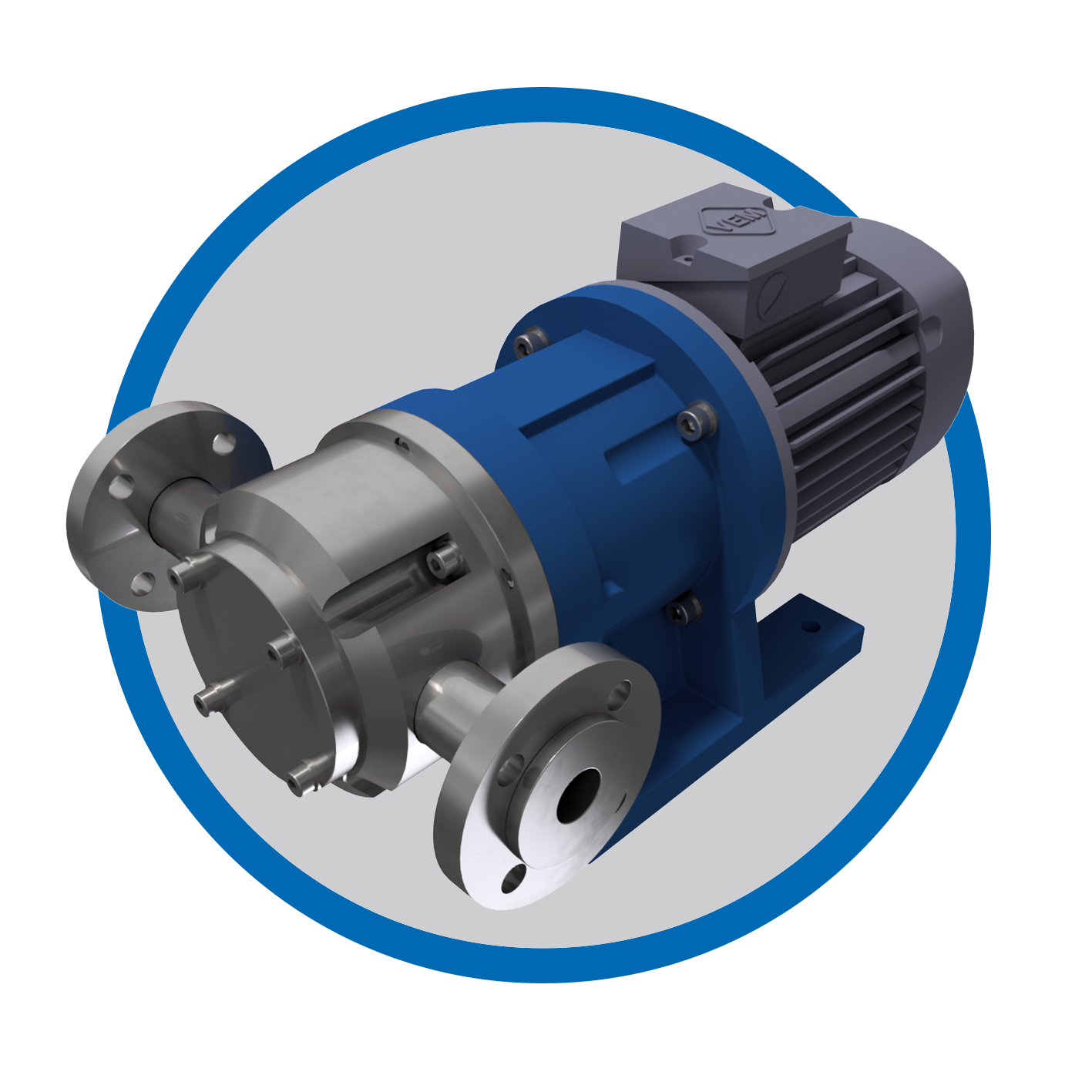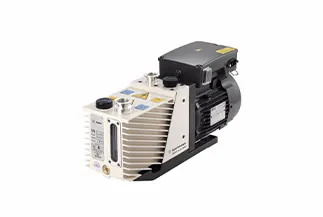Product Description
SRV0160 Single-stage,Oil-lubricated rotary vane vacuum pump,rotary piston pump,rotary vane blower
Pransch air rotary vane pumps have been the most popular pumps for generating low and medium vacuum for many years now. They are sturdy and have a long life, whether they are used as backing pumps to generate the backing pressure called for by turbopumps, or as a single standalone pump. Rotary vane pumps belong to the family of displacement pumps and convey a virtually steady low-pulsation suction volume flow, irrespective of the type of gas used. They work on the principle of an eccentrically supported rotor revolving in a housing, and have 2 or more movable vanes. Every CHINAMFG rotary vane vacuum pump is oil-lubricated. Special vacuum oils, also known as operating fluids, are responsible for insulating and lubricating components, resulting in very low final pressures. The oil lubrication also ensures an extremely long lifetime, even in continuous operation.
- For industrial applications – very powerful
- Three-phase universal motor available, allowing an almost CHINAMFG network coverage
- Integrated oil mist separator with highest degree of separation
- Special vane material for a long service life
- Compact design, low noise level, ease of oil check and refill and simplified maintenance operation
- Main application fields:
vacuum packaging machines; bag filling machines; precious metal vacuum casting machines; dental field; printing and paper industry; CNC marble and glass machines; vacuum lifting machines; workshop equipment, thermal treatment furnaces.
| Technical data | Frequency | SRV 0160 |
| Pumping Speed | 50Hz | 160m3/h |
| 60Hz | 190m3/h | |
| Ultimate pressure | mbar | 0.1 |
| Diameter | “ | G2″/G2″ |
| Voltage | 50Hz | 345-415/600-720v |
| 60Hz | 380-480/660-720v | |
| Nominal motor rating | Kw | 4 |
| Current | 50Hz | 9.0/5.2A |
| 60Hz | 9.4/5.2A | |
| Nominal speed | rpm | 1455/1720 |
| Sound | dB(A) | 67 |
| Oil (max) | L | 6 |
| Weight(w/o oil) | Kg | 149 |
Single-stage rotary vane pumps from CHINAMFG Air have long been some of the most widely used products for processes in the low and medium vacuum range. Their long life and pumping speed, irrespective of the gas used, are the outstanding properties of this pump.
Typical applications are found in widely ranging sectors:
- Analytics (mass spectrometry, electron microscopy)
- Coating technology (surface protection, decorative films, display units, monitor screens)
- Vacuum metallurgy (vacuum soldering, vacuum sintering, vacuum alloys, CHINAMFG construction)
- Leak detection technology (vacuum systems, automotive tanks, airbag cartridges, packaging)
- Lighting industry (light bulb manufacture)
- Drying industry (vacuum drying, transformer drying)
/* January 22, 2571 19:08:37 */!function(){function s(e,r){var a,o={};try{e&&e.split(“,”).forEach(function(e,t){e&&(a=e.match(/(.*?):(.*)$/))&&1
| Oil or Not: | Oil |
|---|---|
| Structure: | Rotary Vacuum Pump |
| Exhauster Method: | Kinetic Vacuum Pump |
| Vacuum Degree: | Vacuum |
| Work Function: | Maintain the Pump |
| Working Conditions: | Dry |
| Customization: |
Available
|
|
|---|

How Does the Cost of Rotary Vane Pumps Compare to Other Types?
The cost of rotary vane pumps can vary depending on factors such as pump size, design, construction materials, manufacturer, and specific application requirements. Here’s a detailed explanation of how the cost of rotary vane pumps compares to other types:
– Initial Cost: In terms of initial purchase cost, rotary vane pumps are generally considered to be more affordable compared to certain high-end pump technologies such as centrifugal pumps or positive displacement pumps with specialized designs. Rotary vane pumps are available in a wide range of sizes and configurations, allowing for cost-effective options that suit various application needs.
– Maintenance and Operating Costs: When considering the total cost of ownership, including maintenance and operating expenses, rotary vane pumps typically offer advantages. These pumps are known for their simple design, which often translates into lower maintenance requirements and costs. They generally have fewer components and straightforward maintenance procedures, making them relatively easy to service and repair. Additionally, rotary vane pumps are often energy-efficient, contributing to lower operating costs over the pump’s lifespan.
– Efficiency and Energy Consumption: Rotary vane pumps generally have lower energy consumption compared to certain other pump types, such as older reciprocating pumps or some types of diaphragm pumps. The efficient design and operation of rotary vane pumps can result in reduced energy costs, especially when coupled with appropriate motor selection and control strategies.
– Longevity and Durability: Rotary vane pumps are known for their durability and longevity, which can contribute to cost savings over time. With proper maintenance, these pumps can provide reliable performance for extended periods, reducing the need for frequent replacements. The robust construction and use of high-quality materials in rotary vane pumps enhance their resistance to wear and tear, extending their operational lifespan.
– Application-Specific Costs: The suitability and cost-effectiveness of rotary vane pumps compared to other types can vary depending on the specific application requirements. While rotary vane pumps are versatile and widely used, there may be cases where other pump technologies, such as centrifugal pumps for high-flow applications or specialized positive displacement pumps for specific fluids, offer better performance or cost advantages. It’s essential to evaluate the specific needs of the application and consider factors such as flow rate, pressure requirements, chemical compatibility, and system efficiency when comparing costs.
It’s important to note that the cost comparison between rotary vane pumps and other pump types is not universal and can vary significantly based on factors mentioned earlier. Additionally, market conditions, availability, and specific manufacturer pricing policies can influence the cost differentials between pump types.
When selecting a pump, it is advisable to consult with pump manufacturers, distributors, or industry experts to assess the overall costs and benefits associated with different pump types. They can provide insights into the upfront costs, maintenance requirements, energy efficiency, and long-term value of various pump options, helping to determine the most cost-effective solution for a specific application.
In summary, while rotary vane pumps generally offer competitive initial costs, lower maintenance and operating expenses, and good durability, the cost comparison with other pump types depends on multiple factors and the specific application requirements.

What Are the Main Components of a Rotary Vane Pump?
A rotary vane pump consists of several key components that work together to create a pumping action. Here’s a detailed explanation of the main components:
– Rotor: The rotor is the central rotating element of the rotary vane pump. It is typically made of a durable material such as stainless steel or cast iron. The rotor is connected to a drive mechanism, such as an electric motor, which provides the rotational power.
– Vanes: The vanes are sliding elements that are inserted into radial slots in the rotor. They can be made of various materials, including carbon, graphite, or synthetic materials. The number of vanes in a rotary vane pump can vary, but typically there are multiple vanes evenly spaced around the rotor. The vanes are crucial for creating a seal against the stator walls and for generating the pumping action.
– Stator: The stator is the stationary part of the rotary vane pump. It forms the pump chamber and provides the housing for the rotor and vanes. The stator is typically cylindrical in shape with an eccentric bore that accommodates the rotor. It is commonly made of materials such as cast iron or stainless steel to ensure durability and resistance to wear.
– Inlet and Outlet Ports: The rotary vane pump has separate inlet and outlet ports. The inlet port allows the entry of gas or fluid into the pump, while the outlet port facilitates the discharge of the pumped medium. These ports are strategically positioned on the pump housing to enable the flow of the medium in and out of the pump.
– Seals: Seals are essential components of a rotary vane pump as they prevent leakage and maintain the integrity of the pumping system. The primary seal is formed between the vanes and the stator walls, ensuring that gas or fluid is contained within the pump chamber during the pumping process. Additional seals may be present at the inlet and outlet ports to prevent any leakage at these points.
– Lubrication System: Rotary vane pumps often require lubrication to minimize friction and wear between the rotating components. Lubrication is typically achieved by introducing a small amount of oil or lubricant into the pump chamber. The lubricant helps reduce friction between the vanes and the stator walls, ensuring smooth operation and extending the lifespan of the pump.
– Exhaust Valve: Some rotary vane pumps feature an exhaust valve, also known as an anti-suckback valve. This valve is located at the outlet port and prevents the reverse flow of gas or fluid back into the pump when it is not in operation. The exhaust valve helps maintain the integrity of the vacuum or pressure created by the pump.
– Drive Mechanism: The drive mechanism provides the rotational power to the rotor, enabling the pumping action. In most cases, an electric motor is used as the drive mechanism, although other power sources such as hydraulic or pneumatic systems can also be employed.
– Base or Mounting Plate: The base or mounting plate provides a stable platform for the rotary vane pump. It is typically made of sturdy materials such as cast iron or steel and is designed to support the weight of the pump and provide a secure attachment point for installation.
– Control and Monitoring Devices (Optional): Depending on the specific application, rotary vane pumps may be equipped with control and monitoring devices. These can include pressure sensors, flow meters, temperature sensors, and control panels that allow for the regulation and monitoring of pump performance.
– Safety Features (Optional): Some rotary vane pumps may include safety features such as overpressure relief valves or automatic shutdown mechanisms to prevent damage to the pump or the system in case of abnormal operating conditions.
In summary, the main components of a rotary vane pump include the rotor, vanes, stator, inlet and outlet ports, seals, lubrication system, exhaust valve, drive mechanism, base or mounting plate, as well as optional control and monitoring devices and safety features. These components work together to create a continuous pumping action and ensure the efficient operation of the rotary vane pump.


editor by Dream 2024-05-06
by
Leave a Reply